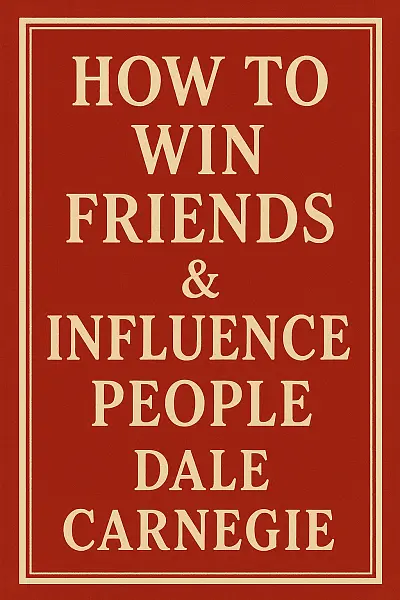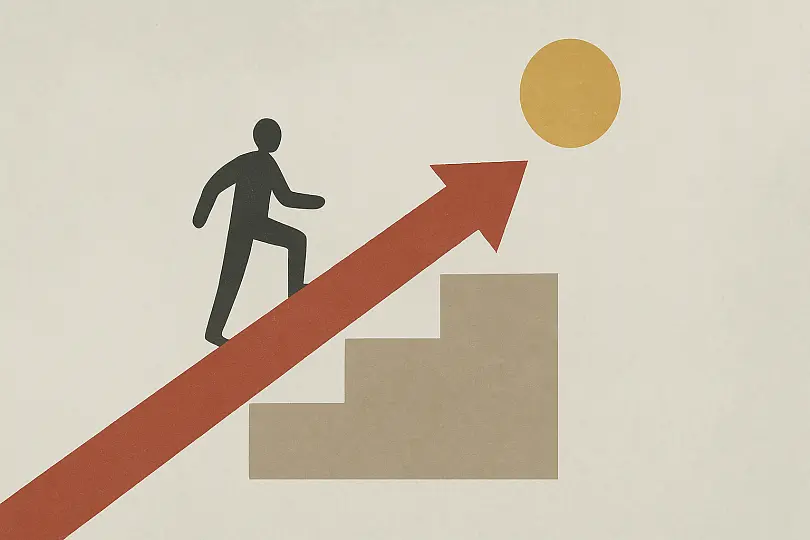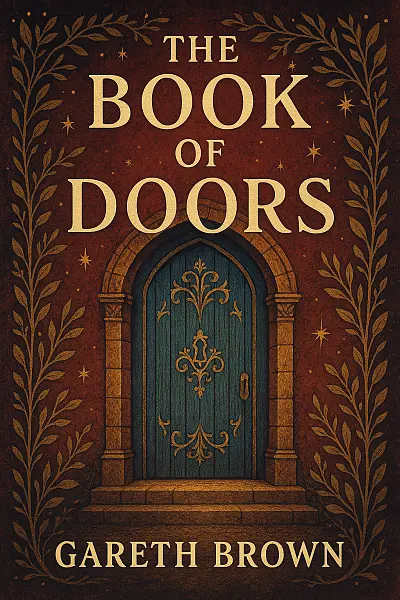
How to Win Friends & Influence People
by: Dale Carnegie
Dale Carnegie starts out as an ordinary guy searching for more meaningful connections in a bustling, competitive world. Feeling isolated and stuck, he’s desperate to break through his social awkwardness and climb the ladder, both professionally and personally.
Everything changes when Dale stumbles onto practical principles that challenge how he relates to others. He’s suddenly faced with the daunting task of changing deeply ingrained habits, risking rejection if he fails to form genuine bonds.
Will Dale manage to bridge the gap between ambition and empathy, or will his journey expose the real cost of truly connecting? The tone is super friendly and empowering, with loads of relatable insights.
"Genuine interest in others is the quiet bridge that turns strangers into allies."
Literary Analysis
Writing Style
Atmosphere
Friendly, warm, and approachable. The whole book has the vibe of a coach cheering you on, effortlessly inviting you into stories from everyday life, business, and history. There’s never any hint of pressure or intimidation—just a gentle encouragement, like sitting down for advice with a trusted mentor over coffee. Expect a hopeful, optimistic mood that puts readers at ease and makes self-improvement feel accessible.
Prose Style
Straightforward, conversational, and practical. Carnegie’s writing reads like a lively chat rather than stuffy instruction. He leans on simple, clear sentences with an informal tone, sprinkling anecdotes generously. There’s a big focus on direct advice, with concise bullet points and memorable slogans that land like advice from a friend. You’ll find zero jargon or fluff—just punchy insights, lots of real-world examples, and plenty of rhetorical questions to keep you thinking.
Pacing
Brisk, energetic, and never bogged down. Carnegie moves quickly from one idea to the next, making each point with a flair for keeping it lively. Short chapters, quick summaries, and repetitive reinforcement mean you never feel overwhelmed. Even if you dip in and out, it’s easy to pick up wherever you left off. The book’s rhythm matches its upbeat, motivational content—quick to inspire, and fast to deliver actionable tips.
Structure & Organization
Intuitive and user-friendly. The content is neatly grouped into thematic sections, each built around easy-to-remember principles. Each chapter opens with a punchy heading, follows with a relatable story, and closes with crisp takeaways. The repetition of core ideas feels intentional, helping readers absorb the advice and revisit it whenever needed.
Voice & Perspective
Empathetic, encouraging, and deeply human. Carnegie’s voice is equal parts coach, confidante, and cheerleader. He never talks down to readers, instead coming across like a wise friend who truly wants you to succeed. His perspective is always rooted in practical optimism, underlining that anyone—regardless of background—can apply these skills.
Overall Feel
Inspiring, accessible, and endlessly practical. This is the rare self-help classic that feels just as fresh now as when it was first published. The style is all about lowering barriers, removing excuses, and translating big ideas into plain, doable steps. If you want a book that feels like an old friend ready to help you level up—this one’s for you!
Key Takeaways
-
Opening with Honest Appreciation: that unforgettable scene where a simple compliment transforms a tense conversation
-
“Let the other person feel the idea is theirs”—Carnegie turns negotiation into emotional judo
-
A sparkling parade of real-life business anecdotes that make advice hit home—think elevator pitches, but warmer
-
“Talk in terms of the other person’s interests”: those lightbulb moments that make you rethink every boring dinner party_
-
Genuine smiles and remembered names—tiny gestures that carry surprising emotional heft throughout
-
That classic “you can’t win an argument” chapter—equal parts humbling and hilarious
-
Every chapter ends like a pep talk from your wisest friend—uplifting, unpretentious, and sneakily profound

Master relationships with timeless tactics for genuine influence.
Reader Insights
Who Should Read This
If you’re someone who loves practical self-improvement books or is curious about classic advice on people skills, How to Win Friends & Influence People could be a game-changer for you. Seriously, if you’re into reading stuff that helps you communicate better—whether for work, networking, or just getting along with your in-laws—this book shines. It’s got that old-school wisdom vibe, packed with real-life stories and super clear tips that are easy to try out in your daily life.
Who’s really gonna vibe with this?
- Fans of motivational reads and personal development books will totally eat this up.
- If you work in sales, management, customer service, or any job where people skills are key, you’ll keep coming back for the advice—it’s full of no-nonsense, actionable ideas.
- Introverts or anyone who gets anxious in social situations: seriously, some of these tips are gold and make socializing waaaay less stressful.
- Even students or recent grads who are just starting to network—this is a great kickstart for building confidence with people.
But, okay, full honesty—
This one’s not for everyone.
- If you can’t stand books that feel a bit “dated”—there’s stuff in here from the early 1900s, and some references are a little old-school, so heads up!
- Readers who like super modern, data-driven psychology might find it a bit anecdotal and maybe a touch repetitive in spots.
- And if you prefer deep literary fiction or crave juicy drama and plot twists…well, this is basically a manual, not a story, so it’s probably not going to hook you.
Bottom line?
If you want to get better at dealing with people (and don’t mind some old-fashioned charm), give it a go. But if you loathe advice books or want something more cutting-edge and scientific, you might want to skip this one.
Story Overview
Looking for a game-changer in the way you connect with others? How to Win Friends & Influence People by Dale Carnegie dives into practical strategies for boosting your communication skills and forging stronger relationships, both personally and professionally.
Centered around the everyday challenge of navigating human interactions, Carnegie introduces timeless principles—think genuine empathy and persuasive positivity—that empower you to make a lasting impression without manipulation.
If you’ve ever wondered how to spark cooperation, earn trust, or just make people feel heard, this classic is packed with memorable stories and down-to-earth tips that’ll soon have you rethinking how you relate to everyone in your orbit.
Main Characters
-
Dale Carnegie: Charismatic narrator and guide whose advice forms the backbone of the book. He stitches together timeless principles with real-life anecdotes to help readers improve their social influence.
-
Charles Schwab: Legendary steel executive showcased as a master motivator and people-person. Consistently highlighted for his knack for sincere appreciation and encouragement.
-
Abraham Lincoln: Historical figure used as a recurring example of empathy and restraint. His journey from harsh critic to gentle persuader models Carnegie’s message of understanding others’ perspectives.
-
John D. Rockefeller: Powerful industrialist whose leadership style is dissected to illustrate the importance of tact and recognizing others’ contributions.
-
Benjamin Franklin: Diplomat and inventor whose self-improvement journey pops up throughout the book. He exemplifies the principles of humility and active listening.
If You Loved This Book
If How to Win Friends & Influence People had you hooked with its blend of practical wisdom and timeless social strategies, you’ll totally vibe with Stephen Covey’s The 7 Habits of Highly Effective People. Both books cut through the noise, laying out foundations for better relationships and communication, but where Carnegie zeros in on personal charm and charisma, Covey takes it a step further—emphasizing integrity, self-mastery, and long-term character growth. You’ll spot that same focus on actionable changes you can implement immediately, but Covey broadens the horizon toward self-leadership and holistic growth.
Carnegie’s approachable insights also bring to mind the conversational magic of Adam Grant’s Give and Take. Grant’s modern twist explores success through generosity and reciprocity—building on those interpersonal skills Carnegie championed, but filtered through the lens of contemporary workplace dynamics. If you’re all about networking without feeling “salesy,” Grant picks up right where Carnegie left off, exploring how being genuine and generous makes a practical difference in today’s interconnected world.
On the screen, there’s a surprising parallel in the hit series Mad Men. The way Don Draper and his colleagues navigate the shifting minefield of postwar advertising is a nuanced dance of persuasion, influence, and human psychology—essentially a dramatic, glamorous echo of Carnegie’s lessons. Every pitch meeting and after-hours cocktail party showcases the power of a well-timed compliment or a finely tuned understanding of what makes people tick—transforming the basics of How to Win Friends & Influence People into a masterclass in mid-century cool.
Whether you crave more action-focused advice, a modern human behavior twist, or you just love watching social skills play out in high-stakes situations, these connections spotlight how Carnegie’s ideas ripple through books and pop culture alike.
Expert Review
Ever found yourself wondering why some people effortlessly attract opportunities—and others get left on the sidelines? Dale Carnegie’s How to Win Friends & Influence People drags that question front and center, poking at the delicate mechanics of charisma, persuasion, and human connection. In a world more networked—and emotionally fraught—than ever, does this Depression-era self-help legend still have genuine insights for modern readers?
Carnegie’s prose is inviting and down-to-earth, striking a clever balance between anecdote and directive. Rather than hide behind dense theory, he leans heavily on lively real-world stories—charmingly dated, at times, but always vivid—illustrating core principles in action. The language is simple, direct, and disarmingly earnest, designed for accessibility rather than literary flair. Repeated key points and memorable lists create an almost mnemonic rhythm: always remember a person’s name, never criticize directly, let the other person feel the idea is theirs. The book’s voice is unfailingly optimistic, if a little paternal, exuding the kind of “you can do this!” confidence that’s fueled its enduring popularity. On the flipside, the repetitive structure—with its endless “rules” and moral tales—can sometimes tip into didactic or even formulaic territory, risking a loss of momentum for readers craving variety or narrative innovation.
Digging beneath the folksy delivery, Carnegie’s central theme is strikingly utilitarian: genuine human relations as the foundation of influence. Principles like empathy, acknowledgment, and sincere appreciation are not mere courtesies, but strategic tools to win cooperation and soften resistance. The book’s insistence on authenticity—no flattery, only honest appreciation—challenges a common criticism of self-help: that it’s about manipulation. Instead, Carnegie makes a subtle distinction between sincere influence and scheming. For today’s audience, faced with digital impersonalization and social anxiety, these reminders feel weirdly radical. Yet the book’s focus on surface-level comportment sometimes sidesteps deeper questions: What about cultural or structural power imbalances? Is relentless positivity always appropriate, or even ethical, in conflict or trauma? While the themes remain relevant, their execution can feel dated, especially for readers informed by contemporary psychology or social critique.
Within the self-improvement canon, Carnegie’s work is the original template—predating Covey’s 7 Habits, Godin’s marketing manifestos, or even Brené Brown’s vulnerability gospel. While modern successors prioritize introspection and inner growth, Carnegie’s approach is relentlessly other-centric, focused on managing impressions and relationships above all else. As a cultural artifact, it pairs neatly with America’s bootstrap optimism and the belief that personality—not privilege—dictates destiny. That optimism, for better or worse, pervades every chapter.
How to Win Friends & Influence People is wildly effective at what it sets out to do: offer practical, actionable advice for navigating human relationships. Its greatest flaw is perhaps its stubborn optimism—glossing over human complexity in favor of tidy formulas. Still, for anyone looking to up their “people skills,” its wisdom is unforgettable, if not always unproblematic. Read it for the clarity, stay for the conversation it sparks about what real influence means in the modern world.
Community Reviews
so I literally couldn’t stop thinking about that bit where Carnegie says remember people’s names. it’s like magic and now I’m weirdly obsessed with using barista names at coffee shops. book changed my social game, not even mad about it
Wasn’t expecting to be quoting “give honest and sincere appreciation” to my cat at 3 AM but here we are. This book snuck into my head and now I’m accidentally nice to strangers. Who knew?
honestly, i picked this up thinking it’d be cheesy but then that bit about remembering people’s names hit me HARD. suddenly i’m questioning every awkward conversation i’ve ever had. did carnegie just make me rethink my social life? yes.
okay so i tried to ignore this book for years but then someone quoted "you can make more friends in two months by becoming interested in other people than you can in two years by trying to get other people interested in you" and now i can’t stop thinking about it
at first i rolled my eyes at the title but then that line about being “genuinely interested in other people” got stuck in my head and now i keep replaying conversations in my mind wondering if i’m just faking it. help
Cultural Context & Discussion
Local Perspective
How to Win Friends & Influence People strikes a unique chord with readers in Japan, where group harmony (wa) and indirect communication are deeply rooted cultural values. Carnegie’s emphasis on empathetic listening and appreciation aligns perfectly with Japanese social etiquette, where maintaining mutual respect and avoiding confrontation is prized.
- Historical parallels can be drawn with Japan’s postwar economic boom, a period when smooth personal relations and persuasive business tactics were vital for success in corporate culture.
- Yet, some concepts—like overt self-promotion or direct flattery—can clash with the Japanese virtue of modesty (kenkyo) and humility. Here, readers may view such tactics with skepticism, finding them a bit out of sync with the understated approach valued locally.
Overall, Carnegie’s advice resonates most where it encourages empathy and active listening, echoing traditional literary themes of subtlety and the importance of reading social cues, while challenging more hierarchical or taciturn aspects of Japanese business culture.
Points of Discussion
Notable Achievement & Cultural Impact
How to Win Friends & Influence People has sold over 30 million copies worldwide since its publication in 1936, becoming an absolute classic that has shaped personal and professional development literature for generations.
This book isn't just a blockbuster in terms of sales—it’s been translated into dozens of languages and is still a go-to resource for anyone wanting to improve their communication and relationship-building skills, whether in business or everyday life. The influence of Dale Carnegie's friendly, practical advice can be felt everywhere from corporate boardrooms to dinner tables—seriously, it’s a cornerstone of self-help!







